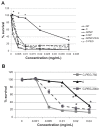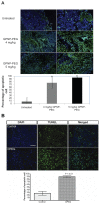Enhancement of anticancer efficacy using modified lipophilic nanoparticle drug encapsulation
- PMID: 22359452
- PMCID: PMC3282612
- DOI: 10.2147/IJN.S28783
Enhancement of anticancer efficacy using modified lipophilic nanoparticle drug encapsulation
Abstract
Background: Development of anticancer drugs is challenging. Indeed, much research effort has been spent in the development of new drugs to improve clinical outcomes with minimal toxicity. We have previously reported that a formulation of lipid gold porphyrin nanoparticles reduced systemic drug toxicity when compared with free gold porphyrin. In this study, we investigated the delivery and treatment efficiency of PEG surface-modified lipid nanoparticles as a carrier platform.
Methods: We encapsulated antitumor drugs into PEG-modified lipid nanoparticles and these were characterized by size, zeta potential, and encapsulation efficiency. The delivery efficiency into tumor tissue was evaluated using a biodistribution study. To evaluate antitumor efficacy, gold porphyrin or camptothecin (a DNA topoisomerase I inhibitor) were encapsulated and compared using an in vivo neuroblastoma (N2A) model.
Results: We showed that drug encapsulation into PEG-modified lipid nanoparticles enhanced the preferential uptake in tumor tissue. Furthermore, higher tumor killing efficiency was observed in response to treatment with PEG-modified lipid nanoparticles encapsulating gold porphyrin or camptothecin when compared with free gold porphyrin or free camptothecin. The in vivo antitumor effect was further confirmed by study of tumor inhibition and positive apoptosis activity. Surface modification of lipophilic nanoparticles with PEG increased the efficiency of drug delivery into tumor tissue and subsequently more effective antitumor activity.
Conclusion: This specific design of a chemotherapeutic agent using nanotechnology is important in the development of a safe and effective drug in cancer therapy.
Keywords: camptothecin; cancer; gold porphyrin; lipid nanoparticles; neuroblastoma.
Figures





Similar articles
-
Development of pH-Sensitive Cationic PEGylated Solid Lipid Nanoparticles for Selective Cancer-Targeted Therapy.J Biomed Nanotechnol. 2017 Feb;13(2):192-03. doi: 10.1166/jbn.2017.2338. J Biomed Nanotechnol. 2017. PMID: 29377649
-
PEGylated lipid nanocapsules with improved drug encapsulation and controlled release properties.Curr Top Med Chem. 2014;14(9):1115-23. doi: 10.2174/1568026614666140329224716. Curr Top Med Chem. 2014. PMID: 24678710
-
Dynamic core crosslinked camptothecin prodrug micelles with reduction sensitivity and boronic acid-mediated enhanced endocytosis: An intelligent tumor-targeted delivery nanoplatform.Int J Pharm. 2020 Apr 30;580:119250. doi: 10.1016/j.ijpharm.2020.119250. Epub 2020 Mar 21. Int J Pharm. 2020. PMID: 32209369
-
Lipid-polymer hybrid nanoparticles as a new generation therapeutic delivery platform: a review.Eur J Pharm Biopharm. 2013 Nov;85(3 Pt A):427-43. doi: 10.1016/j.ejpb.2013.07.002. Epub 2013 Jul 17. Eur J Pharm Biopharm. 2013. PMID: 23872180 Review.
-
Lipid Nanocapsule: A Novel Approach to Drug Delivery System Formulation Development.Curr Pharm Biotechnol. 2024;25(3):268-284. doi: 10.2174/1389201024666230523114350. Curr Pharm Biotechnol. 2024. PMID: 37231750 Review.
Cited by
-
Cuprous oxide nanoparticles selectively induce apoptosis of tumor cells.Int J Nanomedicine. 2012;7:2641-52. doi: 10.2147/IJN.S31133. Epub 2012 May 28. Int J Nanomedicine. 2012. PMID: 22679374 Free PMC article.
-
Immune cell impact of three differently coated lipid nanocapsules: pluronic, chitosan and polyethylene glycol.Sci Rep. 2016 Jan 5;6:18423. doi: 10.1038/srep18423. Sci Rep. 2016. PMID: 26728491 Free PMC article.
-
Micelles Structure Development as a Strategy to Improve Smart Cancer Therapy.Cancers (Basel). 2018 Jul 20;10(7):238. doi: 10.3390/cancers10070238. Cancers (Basel). 2018. PMID: 30037052 Free PMC article. Review.
-
Differentiated neuroblastoma cells remain epigenetically poised for de-differentiation to an immature state.Dis Model Mech. 2023 Dec 1;16(12):dmm049754. doi: 10.1242/dmm.049754. Epub 2023 Dec 27. Dis Model Mech. 2023. PMID: 38095019 Free PMC article.
-
Nanomedicine in Central Nervous System (CNS) Disorders: A Present and Future Prospective.Adv Pharm Bull. 2016 Sep;6(3):319-335. doi: 10.15171/apb.2016.044. Epub 2016 Sep 25. Adv Pharm Bull. 2016. PMID: 27766216 Free PMC article. Review.
References
-
- To YF, Sun RW, Chen Y, et al. Gold (III) porphyrin complex is more potent than cisplatin in inhibiting growth of nasopharyngeal carcinoma in vitro and in vivo. Int J Cancer. 2009;124:1971–1979. - PubMed
-
- Lum CT, Yang ZF, Li HY, et al. Gold (III) compound is a novel chemocytotoxic agent for hepatocellular carcinoma. Int J Cancer. 2006;118:1527–1538. - PubMed
-
- Sun RWY, Che CM. The anti-cancer properties of gold(III) compounds with dianionicporphyrin and tetradentate ligands. Coord Chem Rev. 2009;253:1682–1691.
Publication types
MeSH terms
Substances
LinkOut - more resources
Full Text Sources
Research Materials

